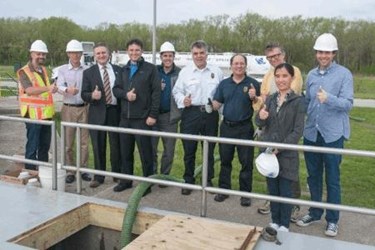Excitement Brews As MWRD Begins Accepting High Strength Organic Materials

As tanker trucks rolled into the Stickney Water Reclamation Plant (WRP) recently, there was one truck in particular that the Monitoring and Research Department at the Metropolitan Water Reclamation District of Greater Chicago (MWRD) was anticipating. It wasn't exactly a beer truck but a tanker hauling liquid waste from a local brewery. Considered a high strength organic material (HSOM), the spent yeast in the truck will promote the MWRD's resource recovery model as a tool for the MWRD to improve and stabilize the enhanced biological phosphorus removal (EBPR) process during water treatment.
It's that process that will lead to increased phosphorus recovery and cleaner waterways and allow local businesses a chance to partner with the MWRD to keep their waste hauls local and serve an integral role in protecting the environment.
"We are happy to announce that we are now in business and accepting trucked wastes at our Stickney and Calumet water reclamation plants," said MWRD President Mariyana Spyropoulos. "This is a major victory in protecting our water environment and for local businesses looking to do their part in lowering their carbon footprint. We credit our staff who toiled away at this project for two years, testing materials and finding potential candidates to contribute this critical ingredient that will help us recover more phosphorus from the water treatment process."
What makes the liquid waste from breweries and sugary and starch liquid wastes special for the EBPR process is the readily biodegradable carbon that serves as food for the phosphorus accumulating organisms that work under anaerobic and aerobic conditions in the secondary treatment. These organisms work to remove organic material from wastewater and to recover more phosphorus than normal microorganisms.
MWRD officials believe this will lead to significant increases in the amounts of fertilizer produced at the new Stickney WRP nutrient recovery facility that can be marketed to agricultural producers and bring a return on investment. Equally as important, this recovery will lead to less phosphorus in waterways downstream that could contribute to algae blooms and hypoxic conditions as far away as the Gulf of Mexico.
After learning about the MWRD's plans, local breweries like Goose Island Beer Company and Revolution Brewing were excited to participate. They partnered with 1212 Environmental, which specializes in fully managed waste reduction and recycling programs, to have the liquid waste delivered to the MWRD.
Goose Island Assistant Brewery Manager Ian Hughes said, "Goose Island got involved with the MWRD's Bio-P program to enhance their innovative resource recovery program and to support their vital goal of protecting regional water quality. We have a vested interest in clean water because it is one of the most important ingredients we use for making beer - it is the blank canvas upon which our brewers paint their masterpiece with malt, hops and yeast!"
"That being said, we were excited to create an innovative byproduct synergy with our wastewater regulator by diverting our spent yeast from the drain and sending it directly to the MWRD for use in their enhanced biological phosphorus removal and recovery program. It is a win-win partnership as we decrease the strength of our brewery wastewater, find a new life for our 'waste' byproduct, and in the process we support the MWRD's exciting resource recovery efforts."
The MWRD is accepting non-hazardous HSOM containing elevated concentrations of chemical oxygen demand (COD) concentrations of 75,000 mg/L or above. Examples of acceptable HSOM are food processing, brewery, restaurant and sugary/starchy wastes which are homogenous liquids, or slurries high in organic content that are typically too concentrated to be disposed of by discharge to the sewer system. Spent yeast, grains and hops are examples of wastes that breweries can deliver to the MWRD. Such trucked materials would not be subject to provisions of the MWRD's User Charge Ordinance.
A sample from each delivery is tested by MWRD environmental specialists. The tanker trucks make a $250 payment for deliveries of 5,000 gallons and $50 or $25 for a 1,000- or 500-gallon delivery, respectively.
"These first trucks that came rolling in today are the first of many, and we thank Goose Island and Revolution Brewing for their participation and commitment to the local environment," said MWRD Commissioner David J. Walsh. "This is an exciting opportunity for the enhanced biological phosphorus removal process. We are not only protecting our water environment but becoming pioneers in an emerging field of water treatment and resource recovery and providing a return to taxpayers and the environment."
About The Metropolitan Water Reclamation District of Greater Chicago
Established in 1889, the MWRD is an award-winning, special purpose government agency responsible for wastewater treatment and stormwater management in Cook County, Illinois. For more information, visit www.mwrd.org.
Source: The Metropolitan Water Reclamation District of Greater Chicago
